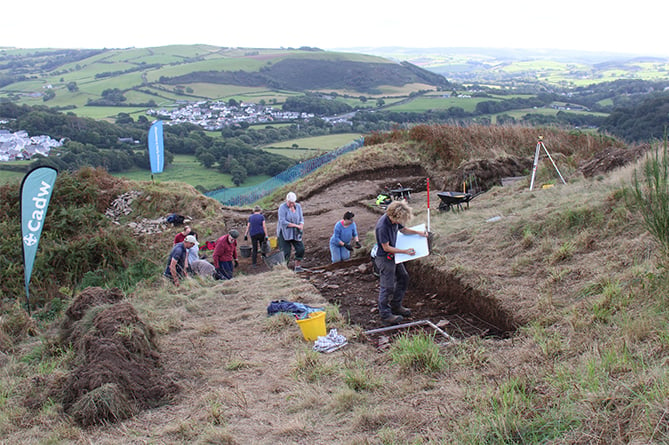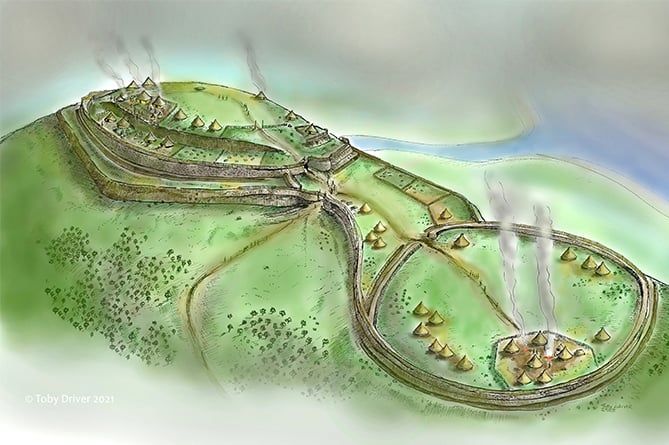Excavations at Ceredigion’s largest hillfort will soon begin as part of a community-based project. The work will be possible thanks to a £143,243 funding grant by the National Lottery Heritage Fund, on top of funds from the Welsh Government’s historic environment service, Cadw.
The Pen Dinas hillfort peering over Penparcau, which historians once thought to have been inhabited during the Iron Age, may potentially date back a previous thousand years – meaning it may have stood since the Bronze Age.
Last year, archaeologists conducted a geological survey there, the first of its kind at the site, which resulted in the discovery of a burial mound. Indications from the mound suggest the site was inhabited between 1,200 and 700BC.
That three-week excavation took place last September and was led by the Dyfed Archaeological Trust and uncovered many more artefacts and clues that helped historians imagine how the hillfort once would have looked, and how the people living within its walls would have lived so many years ago.

The new funding will allow for a two-year project on the site to be undertaken by the archaeological trust, along with the Royal Commission on the Ancient and Historical Monuments of Wales (RCAHMW) and local groups, including the Penparcau Forum.
Dr Toby Driver, the RCAHMW’s senior investigator and aerial surveyor, called the forum “a real force of nature”, commending it for getting the ball rolling on the projects, and setting the stage for both excavations on Pen Dinas to take place.
Last year’s investigation found evidence of houses, some with walls that were still standing almost 3,000 years after the hillfort was constructed.
Dr Driver said the most exciting find was the discovery of an amber bead which he said could only have come from the north-western areas of Britain that border the North Sea —showing how far and wide the trade at Pen Dinas was at a time without roads or the use of wheels. The oldest wheel to have ever been found in the UK was dated to anywhere between 1,300 to 800BC.
Dr Driver told the Cambrian News that Pen Dinas was “the place to go” for trade, which helps explain why such an exotic artefact could have ended up all the way over on the west of Wales.
Pen Dinas is one of 250 hillforts known to have existed throughout Ceredigion, and one of the 700 pre-Roman forts found throughout Wales. But out of all of them, the four-hectare Pen Dinas hillfort may have been one of the most prominent in the country — and must have been run by some notably powerful leaders, Dr Driver says.

Positioned at the mouths of both the Ystwyth and Rheidol rivers, sitting atop Tanybwlch beach, the site had immense control over trade routes, regional waterways and the sea, as well as being a natural fortification. As if this wasn’t enough for an invading tribe to deal with, the position of the hillfort guaranteed any attackers who dared try would be enclosed in one of the two bottlenecks that gave access to it.
All of this made the site incredibly valuable and incredibly defensible, making any attempt to invade it much more than an uphill battle — especially when this defensive position was combined with the hillfort’s wooden walls, and deadly slingshots its inhabitants armed themselves with in its defence. These weapons could fracture an invader’s skull from a range of more than 60 yards.
The groups working on the project hope they can engage the local community in even more of the site’s history, with volunteers encouraged to take part in the upcoming work.
Dr Driver told the Cambrian News that the team is working on a 3D reconstruction of what the hillfort would have looked like all those years ago.
A new community outreach officer will be hired to promote the work within the local community, and will also visit local schools to tell the Pen Dinas story.
Dr Driver said the groups will be working closely with the Penparcau wildlife forum and will spend time during the autumn and winter clearing bracken, trees and other vegetation, and restoring the site’s grassland — designated a local nature reserve because of its popularity for nesting birds, and the rare plants that grow there.
Pen Dinas was originally known as Dinas Maelor after the famous giant king of Welsh mythology, Maelor Gawr who, according to fables, built his castle — Castell Maelor —within the settlement, the ‘dinas’, or city of Maelor.
The tale, which was recorded in Sion Dafydd Rhys’ 16th century writings Olion Cewri Cymru, (the Giants of Wales and their dwellings), sees Maelor, or Maylor as he was spelt within it being captured and sentenced to death in the Cwmwd of Cyfeilog – roughly 12 miles from Pen Dinas. Before this, however, Maelor’s captors granted his last wish of sounding a horn three times. He blew on the horn so intensely that in the process, he lost his beard, hair, finger and toenails the first two times, and shattered the horn itself on the third. But little did his captors know that this was a signal to his three sons, Cornippyn, Crygyn and Bwba letting them know their father was in trouble. Cornippyn, who was out hunting when he heard the call, rode so hard towards his father that he tore the head off his dog and cleared the river Ystwyth in a single leap.
Unfortunately, Cornippyn, Crygyn and Bwba all died in this tale: Cornippyn at the battle with his father’s captors; and Crygyn and Bwba by a single unnamed warrior who covered the six miles between them and slaughtered both in their strongholds of Llanilar and Llanbadarn Fawr on the same night.
Although the excavations are highly unlikely to discover evidence of such mythical characters, the excavation promises to uncover as much from the site as they can, celebrating the dig with a weekend display at the end of the project.

.png?width=209&height=140&crop=209:145,smart&quality=75)



Comments
This article has no comments yet. Be the first to leave a comment.